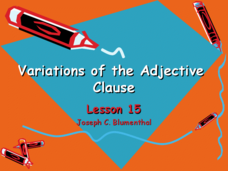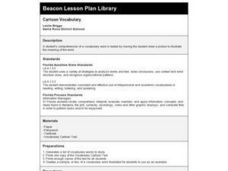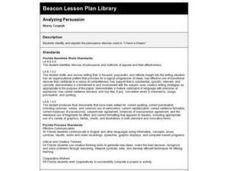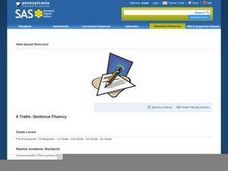Education Development Center
Consecutive Sums
Evaluate patterns of numbers through an engaging task. Scholars work collaboratively to determine a general rule reflecting the sum of consecutive positive integers. Multiple patterns emerge as learners explore different arrangements.
Curated OER
Variations of the Adjective Clause: Lesson 15
Help your students to vary their sentence structure with this presenation, which teaches them to use relative pronouns and adjective clauses to change the order of their sentences. The presentation details different ways to write the...
University of North Carolina
Poetry Explications
Explication may sound like a fancy word, but it's just a fancy way to say analysis. Using a handout on poetry explications, part of a larger series on specific writing assignments, writers learn how to break down and analyze a poem. The...
Curated OER
Metaphors
Metaphors open doors to descriptive language for your poets. They read the poem "What is the Sun" and record all the metaphors they find. Then, scholars change one of them to a simile. After answering two more comprehension questions,...
Curated OER
Investigate Science Using Crayfish
Young scientists discover the importance of scientific investigation by observing live crayfish. They carefully observe the patterns of crayfish in different environments. Then they discuss their conclusions and define what all living...
Missouri Department of Elementary
What Color is Your Apple?
Build your classroom community with an activity that uses apples to examine oneself and their classmates. Participants draw four large apples on blank paper then exchange them within a small group. Group members write a character trait...
Curated OER
Writing with Style: Six Traits of Good Writers
Fourth graders listen as the teacher reads a picture book that emphasized word choice. They discuss words and how word choice impacts a piece of writing. Students view various passages on the overhead, and highlight adjectives and verbs...
Curated OER
I Went Walking Lesson Plan
Learners study writing structure and patterns in repetitive texts. In this writing structure instructional activity, students read portions of a story and predict what will come next based on the repetitive text. Learners create their...
Pennsylvania Department of Education
6 Traits: Organization
Students make logical patterns in their writing to demonstrate the trait of organization. In this organization lesson plan, students focus on events proceeding logically.
Curated OER
Two Plus Two
Students solve simple math problems in the target language using words instead of numberals. They use the appropriate interpretive strategies to compute in the taget language. Students use complex language structures to solve the...
Curated OER
Analogies
Students find the missing words in analogies while working in groups. They complete an analogy worksheet.
Curated OER
Deep Roots of Ancient Greece
Young scholars investigate Greek contributions to modern America. In this ancient Greek influence lesson, students watch videos, listen to lectures, and conduct research regarding ancient Greek ideals in order to analyze and trace Greek...
Curated OER
WORDS FRANKLY SPOKEN
Students visit appropriate websites to discover quotes from Franklin's Poor Richard's Almanac. Working in pairs, they choose three quotes on which to elaborate and then write two original quotes.
Curated OER
Cartoon Vocabulary
Third and fourth graders complete a vocabulary log which includes a definition, and a sentence that demonstrates the meaning of the word. Then make an illustration that represents the definition of the word. The trick is that they may...
National Endowment for the Humanities
Arabic Poetry: Guzzle a Ghazal!
Learners research the evolution and cultural significance of the Arabic ghazal form of poetry. They, in groups, compose an original ghazal poem and read it aloud to the class.
Mr. Ambrose
The Great Gatsby, F. Scott Fitzgerald
Good discussion questions, quizzes, and tests teach as well as assess. Readers of The Great Gatsby will learn much from the materials in a 36-page packet designed to help students prepare for the AP Literature exam. Included in the...
Scholastic
Will He See His Shadow? Groundhog Day Activities
What a fantastic collection of activities for celebrating Groundhog Day! This resource includes a variety of holiday reading selections, groundhog facts, links to printables, story comprehension lessons, and much more!
Curated OER
World Cities
High schoolers examine the settlement patterns of world cities. In groups, they are given a region of the world and asked to create a city in the location. They are given a set of characteristics of the city and determine what would be...
Curated OER
Investigation Can You Build This?
Students work in small groups to explore spatial relationships while building with color cubes. Students must identify positions of blocks to partner, recreate a model, and color a sketch of their structure appropriately.
Curated OER
World Cities of 5 Million or More
Students consult online resources to identify and map the world's largest cities and metropolitan areas. They analyze birth rates, settlement patterns and other demographic data and make predictions for the future. They write essays...
Curated OER
Analyzing Persuasion
A reading of Dr. Martin Luther King Jr.'s "I Have a Dream" speech launches a study of rhetorical devices such as hyperbole, allusion, metaphor, simile, personification, connotative language and parallel structure. Class members then...
Curated OER
Bursting Stereotypes
Ninth graders discuss the importance of respecting others. After popping balloons, they use paper strips to write words representing stereotypes for men and women. In groups, they share their list and identify those that could be used...
Pennsylvania Department of Education
6 Traits: Sentence Fluency
Students practice writing with sentence fluency in order to make the story more enjoyable for the reader. In this sentence fluency lesson plan, students focus on rhythm and flow.
Curated OER
Those Cells Look Good Enough to Eat
Students explore the parts of the cell. In this cell lesson, students use foods to create cell models that represent the nucleus, cytoplasm, cell membrane, mitochondria, ribosomes, vacuoles, endoplasmic reticulum, and Golgi bodies...

























